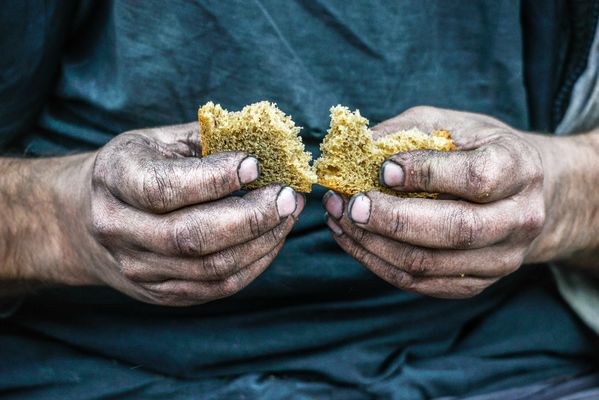5.2.1
Defining Poverty
Defining and Measuring Poverty
Defining and Measuring Poverty
Poverty is defined in two broad ways: absolute and relative poverty.


Wealth and income
Wealth and income
- Stratification involves the unequal distribution of resources, including wealth and income.
- Wealth refers to the ownership of assets such as houses and land as well as savings and shares.
- Income refers to the flow of resources the individuals and households receive over a specific period of time, such as a monthly salary.


Defining poverty
Defining poverty
- Poverty is defined in two broad ways: absolute and relative poverty.
- Absolute poverty is when income is insufficient to obtain the minimum needed to survive.
- Relative poverty is when income is well below average, so that people are poor in comparison to others.


Measuring poverty
Measuring poverty
- The UK government measures poverty in terms of low incomes and this is defined as 60 percent of the median (or middle point) income of the population after housing costs.


Subjective poverty
Subjective poverty
- Subjective poverty is based on whether people see themselves as living in poverty.
,h_400,q_80,w_640.jpg)
,h_400,q_80,w_640.jpg)
Environmental poverty
Environmental poverty
- Environmental poverty measures deprivation in terms of conditions such as inadequate housing and air pollution.
Relative Poverty
Relative Poverty
Townsend developed a deprivation index to measure relative deprivation that listed 12 items to discover how many people were living in poverty in the UK.


Townsend
Townsend
- Peter Townsend (1979) wanted to discover how many people were living in poverty in the UK.
- Townsend developed a deprivation index to measure relative deprivation that listed 12 items, including, ‘Household does not usually have a Sunday joint (3 in 4 times)’.


Findings
Findings
- Townsend found that nearly 23 percent of the UK population were in poverty.
- This was much higher than that based on the state standard of poverty (6.1 percent) and the relative standard of poverty (9 percent).


Criticisms of Townsend
Criticisms of Townsend
- Critics question some of the items on the list and how they were selected.
- For example not eating meat (a Sunday joint) regularly is not necessarily linked to deprivation and may be linked to religious beliefs.
- If the index is inadequate, then the statistics based on it are unlikely to be valid.
1The Sociological Approach
1.1Introduction to Sociology
1.2Sociological Approaches
1.3The Consensus vs. Conflict Debate
2Families
2.1Functions of Families
2.2Family Forms
2.3Conjugal Role Relationships
2.4Changing Relationships Within Families
2.5Criticisms of Families
3Education
3.1Roles & Functions of Education
3.2Processes Within Schools
4Crime & Deviance
4.1The Social Construction of Crime
4.2Social Control
4.3Criminal & Deviant Behaviour
5Social Stratification
5.1Social Stratification
5.2Poverty as a Social Issue
6Sociological Research Methods
6.1Research Methods
6.1.1Research Design
6.1.2The Scientific Method
6.1.3Other Considerations
6.1.4Primary Sources
6.1.5Secondary Sources
6.1.6Surveys
6.1.7Sampling
6.1.8Questionnaires
6.1.9Interviews
6.1.10Observation
6.1.11Statistics
6.1.12Case Studies
6.1.13Longitudinal Studies
6.1.14Ethnography
6.1.15Experiments
6.1.16Small Scale Research
6.1.17End of Topic Test - Research Methods
Jump to other topics
1The Sociological Approach
1.1Introduction to Sociology
1.2Sociological Approaches
1.3The Consensus vs. Conflict Debate
2Families
2.1Functions of Families
2.2Family Forms
2.3Conjugal Role Relationships
2.4Changing Relationships Within Families
2.5Criticisms of Families
3Education
3.1Roles & Functions of Education
3.2Processes Within Schools
4Crime & Deviance
4.1The Social Construction of Crime
4.2Social Control
4.3Criminal & Deviant Behaviour
5Social Stratification
5.1Social Stratification
5.2Poverty as a Social Issue
6Sociological Research Methods
6.1Research Methods
6.1.1Research Design
6.1.2The Scientific Method
6.1.3Other Considerations
6.1.4Primary Sources
6.1.5Secondary Sources
6.1.6Surveys
6.1.7Sampling
6.1.8Questionnaires
6.1.9Interviews
6.1.10Observation
6.1.11Statistics
6.1.12Case Studies
6.1.13Longitudinal Studies
6.1.14Ethnography
6.1.15Experiments
6.1.16Small Scale Research
6.1.17End of Topic Test - Research Methods
Unlock your full potential with Seneca Premium
Unlimited access to 10,000+ open-ended exam questions
Mini-mock exams based on your study history
Unlock 800+ premium courses & e-books
